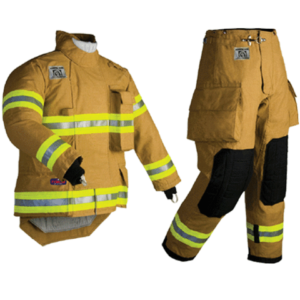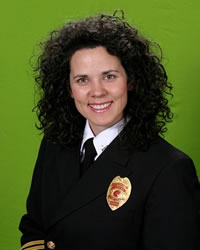By: Robert Avsec, Executive Fire Officer
Recently, I did a piece on what’s under your turnout gear where I wrote about the current state of fire resistant (FR) station wear and  FR undergarments. The focus was on how important new developments are and how important it is to have that “second line of protection” against thermal burns.
FR undergarments. The focus was on how important new developments are and how important it is to have that “second line of protection” against thermal burns.
Well, shortly after that article published I received an e-mail from a fire service colleague, Katherine Ridenhour, a retired battalion chief who served with the Aurora (Colo.) Fire Department for 24 years.
Hi Chief,
I enjoy your articles very much. I have a concern/question regarding the real safety of fire resistant station wear. The chemicals used in producing “safer” station wear may be up for question however, as to their effects on us humans wearing and sweating and overheating in them…
A big issue with fire retardants in general is that they disrupt the endocrine system and can cause autoimmune diseases such as I have (Hashimoto’s disease). I am not alone in thinking this and have included two of many articles that voice concern over this issue—even if the clothing/articles are not subject to sweating and internal body temp increases.
[Note: Your skin’s permeability increases with temperature and for every 5-degree increase in skin temperature, absorption increases by 400%. Source: Firefighter Cancer Support Network].
I try to alert all women, especially women firefighters, to get their full hormone and thyroid panel [of medical blood work] done in their early 40’s since usually they will be getting those tests around menopause time anyway.
I personally know several women firefighters who do have autoimmune system issues. In one department in the Denver Metro area, out of the 9 or 10 women on the job, 6 of them had Hashimoto’s disease. Because I learned of that, I got tested and was found to be OK.
Until I went the following year to a specialist who understood autoimmune issues and said that the previous tests were incomplete  as most docs do not understand how to test for the full thyroid spectrum. My former male fire officer [with Aurora Fire Department] also has Hashimoto’s (though it’s much more common in women) and I know women firefighters that have had thyroid cancer as well as Sjogren’s syndrome—a really terrible autoimmune disease, worse than Hashimoto’s.
as most docs do not understand how to test for the full thyroid spectrum. My former male fire officer [with Aurora Fire Department] also has Hashimoto’s (though it’s much more common in women) and I know women firefighters that have had thyroid cancer as well as Sjogren’s syndrome—a really terrible autoimmune disease, worse than Hashimoto’s.
I believe that my disease was indeed caused by chemicals (not rocket science to figure that one out) and I am retired now. However, if I was still on the job, I would do my due diligence and probably not wear the fire-resistant clothing. I would much rather rely on my skills of reading fire and smoke, understand the risk/benefit considerations on scene, know when to send my troops interior and especially when to pull them out (I was a BC for my last 7 years). And teach the craft of analyzing survivability profiling rather than relying on clothing that may be causing me physical harm every time I wear it.
These are the two links that Chief Ridenhour shared in her message to me.
Can Wearing Fire-Retardant Pajamas Affect Your Child’s Health?
Flame Retardants Do More Harm Than Good, Research Shows
Every firefighter and their family members should view this 13-minute video which contains some astounding historical data that’s

Battalion Chief (Ret.) Katherine Ridenhour
even more pertinent in today’s discussion about firefighter exposures and firefighter cancer rates.
Thank you Chief Ridenhour for your message and your references. In our continuing quest to better protect firefighters from the hazards of interior structural firefighting, we must continue to keep an open mind, do our due diligence, and share what we learn with each other.
About the Author
Battalion Chief (Ret.) Katherine Ridenhour served with the Aurora (Colo.) Fire Department for 24 years. Her experience includes EMT-Paramedic, Tech Rescue, Training Officer, EMS Chief, Employee Diversity Board President and Recruitment Team Leader and she is currently serving her community as a volunteer firefighter.
Chief Ridenhour has an extensive teaching background presenting a vast array of subjects at many national and state conferences including IAFC, IAFF and FDIC and organizations ranging from military to large metro cities such as San Diego, Denver, Los Angeles and San Francisco. In addition, she is a current member and past President of the International Association of Women in Fire and Emergency Services.
 Fire & EMS Leader Pro The job of old firefighters is to teach young firefighters how to become old firefighters!
Fire & EMS Leader Pro The job of old firefighters is to teach young firefighters how to become old firefighters!